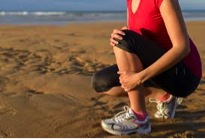What are Shin Splints or Medial Tibial Stress Syndrome ?
 With the winter sports season fast approaching we would like to talk about a condition that commonly occurs when athletes intensify or change their training routines.
With the winter sports season fast approaching we would like to talk about a condition that commonly occurs when athletes intensify or change their training routines.
Commonly known as ‘Shin Splints’, Medial Tibial Stress Syndrome refers to pain along the shin bone (tibia).
It is common in sports that involve running and for dancers.
The exact cause of the pain is not well understood but it most probably comes from pulling of the muscles along their attachment to the bone causing inflammation at the junction of the muscle and bone. In more severe cases it can also involve a stress response in the bone itself.
What are the symptoms of Shin Splints ?
1. Aching and pain along the shin bone – either on the inside (in the case of medial shin splints) or the outer edge (anterior shin splints) or in severe cases – both.
2. Tenderness to touch along the ridge of the shin bone
3. The area over the ridge of the shin bone may be red and inflamed
4. At first the pain is often worse at the start of a run or game then eases off as you warm up. As it gets more severe it doesn’t ease and you may also notice pain after exercise has stopped.
What are the causes of Shin Splints ?
-
- Exercising too hard and/or progressing too quickly following a break in training
- Poor foot posture- excessive rolling in (pronation) can put added load on the shin muscles. While lack of any pronation (a very ridged foot) can cause more stress to travel up through the shin bone. Both leading to shin splints.
- Exercising on hard surfaces like concrete or sports fields that are very dry.
How are Shin Splints managed?
Shin splints can easily become a chronic problem and may lead to more severe injuries such as stress fractures so it is best to see you physiotherapist as soon as you start to develop pain in the shins. We can advise you of how best to taper your training and modify your exercise environment.
We also help to correct any postural imbalances that may be contributing to the problem and advice on appropriate stretches and strength work. We can also refer you for any relevant investigations to rule out more sinister causes such as stress fractures or anterior compartment syndrome.
In the meantime icing the area of pain for 20min after exercise, relative rest and NSAIDS as prescribed by your medical professional can all help.
Cross training with an emphasis on low impact exercise such as swimming or cycling may enable you to maintain your cardiovascular fitness while the shins heal.
Prevention is key
It is best to prevent shin splints before they occur. You can help yourself avoid getting this irritating and sometimes serious condition by :
- Starting out slowly with a new program and building intensity and length of time gradually.
- Cross train from the beginning and allow for adequate rest time between more intense exercise sessions.
- Pick soft surfaces to run on if possible – run on the grassy verge rather than the foot path.
- Make sure your running shoes are not worn out as they will absorb less shock and more will be transmitted up the shin bone. Also ensure you don’t get tempted to over support the ach of your foot by purchasing shoes with high and ridged arch supports – some rolling in (pronation) is necessary for shock absorption.
Finally – catch it earlier – shin splints are much easier to treat if we see them when the pain first starts to appear.
As mentioned this is usually at the start of a run/ exercise session, even if the pain eases as you get warmed up.
